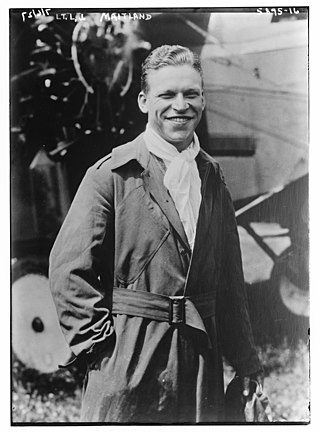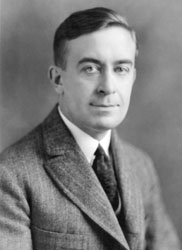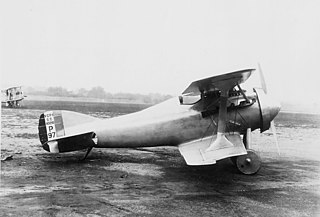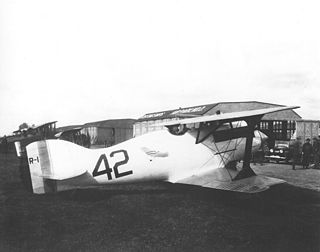This is a list of aviation-related events from 1921:

Russell Lowell Maughan was an officer in the United States Army and a pioneer aviator. His career began during World War I, and spanned the period in which military aviation developed from a minor arm of the Army Signal Corps to the huge Army Air Forces on the verge of becoming a separate service.

The National Air Races are a series of pylon and cross-country races that have taken place in the United States since 1920. The science of aviation, and the speed and reliability of aircraft and engines grew rapidly during this period; the National Air Races were both a proving ground and showcase for this.

Selfridge Air National Guard Base or Selfridge ANGB is an Air National Guard installation located in Harrison Township, Michigan, near Mount Clemens. Selfridge Field was one of thirty-two Air Service training camps established after the United States entry into World War I in April 1917.

The P-1 Hawk was a 1920s open-cockpit biplane fighter aircraft of the United States Army Air Corps. An earlier variant of the same aircraft had been designated PW-8 prior to 1925.

Lester James Maitland was an aviation pioneer and career officer in the United States Army Air Forces and its predecessors. Maitland began his career as a Reserve pilot in the U.S. Army Air Service during World War I and rose to brigadier general in the Michigan Air National Guard following World War II.

The Curtiss R3C is an American racing aircraft built in landplane and floatplane form. It was a single-seat biplane built by the Curtiss Aeroplane and Motor Company.

The Curtiss CR was a racing aircraft designed for the United States Navy in 1921 by Curtiss. It was a conventional single-seater biplane with a monocoque fuselage and staggered single-bay wings of equal span braced with N-struts. Two essentially similar landplane versions were built as the CR-1 and CR-2, which were both eventually converted to seaplanes as the CR-3 in 1923 and CR-4 in 1924. A refined version was developed for the US Army Air Service under the designation R-6. These latter two aircraft featured refined aerodynamics included surface-mounted radiators.

The Curtiss R2C was a racing aircraft designed for the United States Navy in 1923 by Curtiss. It was a single-seater biplane with a monocoque fuselage and staggered single-bay wings of unequal span braced with I-struts. The aircraft's advanced streamlining featured a top wing mounted directly to the top of the fuselage and surface-mounted radiators for cooling the engine. The aircraft was originally designed and built as a landplane under the Navy designation R2C-1, of which two examples were produced. One was converted into a seaplane version known as the R2C-2 the following year.

The Thomas-Morse MB-6 was an American racing aircraft built by Thomas-Morse Aircraft for the US Army Air Service.

The Wright F2W was an American racing aircraft built by Wright Aeronautical Corporation for the US Navy.
Lowell Richard Bayles was an American air race and stunt pilot from the "Golden Age of Air Racing." He was the winner of the 1931 Thompson Trophy flying the Gee Bee Model Z. He was killed during an attempt at the landplane speed record when the Model Z he was flying crashed at over 300 miles per hour (483 km/h) mph.

Alfred Victor Verville was an American aviation pioneer and aircraft designer who contributed to civilian and military aviation. During his forty-seven years in the aviation industry, he was responsible for the design and development of nearly twenty commercial and military airplanes. Verville is known for designing flying boats, military racing airplanes, and a series of commercial cabin airplanes. His planes were awarded with the Pulitzer Speed Classic Trophy in 1920 and 1924.

The Verville-Sperry R-3 was a cantilever wing racing monoplane with a streamlined fuselage and the second aircraft with fully retractable landing gear, the first being the Dayton-Wright RB-1. In 1961, the R-3 racer was identified as one of the "Twelve Most Significant Aircraft of all Time" by Popular Mechanics magazine. In 1924, an R-3 won the Pulitzer Trophy in Dayton, OH.

The Verville VCP was an American single-engined biplane fighter aircraft of the 1920s. A single example of the VCP-1 was built by the United States Army Air Service's Engineering Division, which was later rebuilt into a successful racing aircraft, while a second, modified fighter was built as the PW-1.

The Thomas-Morse R-5 also known as the TM-22 was an American single-engined parasol monoplane racing aircraft of the 1920s. Two were built for the United States Army Air Service in 1922, but after competing in the 1922 Pulitzer Trophy Race the type was abandoned.

Lieutenant Cyrus K. Bettis was an American army aviator who won several races and set the then airspeed record for a closed-circuit race in 1925. He died after he crashed his aircraft less than a year later.

The Verville-Packard R-1 was a military racing aircraft that was modified from Alfred V. Verville's previous Verville VCP-1 design. The R-1 is sometimes known also as the Verville-Packard VCP-R or the Verville-Packard 600. The R-1 was the first racing aircraft built for the United States Army Air Corps.

Corliss Champion Moseley was a United States Army aviator and later civilian trainer. He won the inaugural Pulitzer Air Race in 1920. Following his service in World War I, where he was credited with one aerial victory, he was placed in charge of all United States Army Air Service schools. As a civilian, he set up flying schools which are estimated to have taught over 25,000 pilots and 5000 mechanics, mostly for service in World War II. He was also a business executive, either helping found or organize Western Air Express.

















